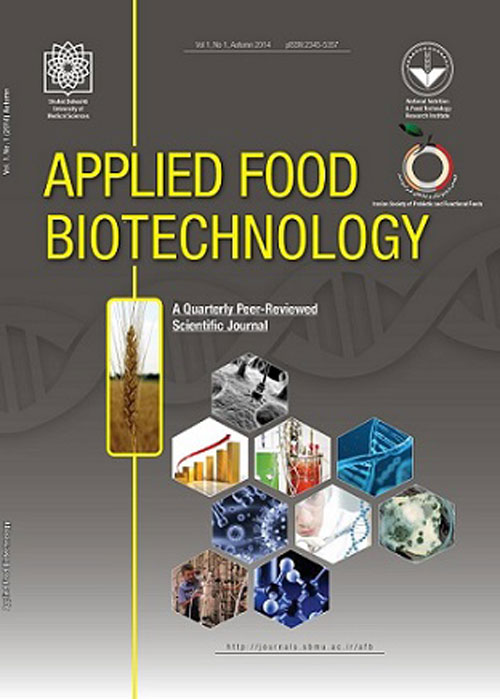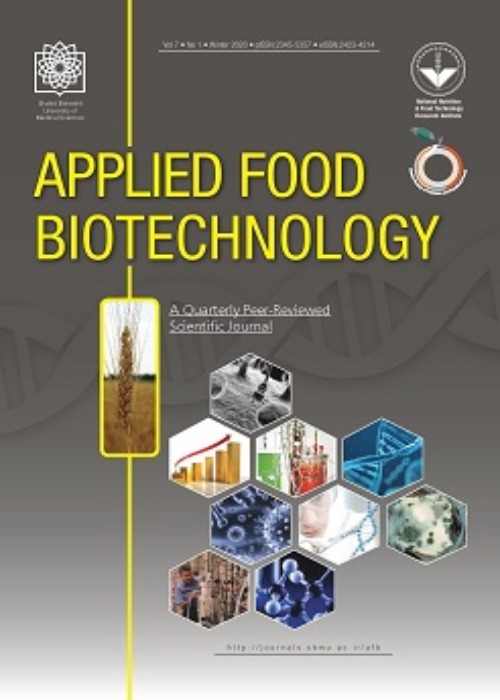فهرست مطالب

applied food biotechnology
Volume:3 Issue: 2, Spring 2016
- تاریخ انتشار: 1395/02/10
- تعداد عناوین: 7
-
-
Pages 72-81Background And ObjectivesNovel probiotics and prebiotics designed to modulate the gut microbiota for improving health outcomes are in demand as the importance of the gut microbiota in human health is revealed. A review of the scientific literature regarding the current knowledge and novel species and novel oligosaccharides for the treatment of dysbiosis-associated diseases has been carried out due to their growing interest.
Results andConclusionsThe regulations governing introduction of novel probiotics and prebiotics vary by geographical region. Novel foods and foods with health claims fall under specific regulations in several countries. In European Union (EU), safety is assessed by novel food approval process and by the European Food Safety Authority (EFSA) established Quantitative Presumption of Safety (QPS) system for bacteria and other biologicals. Any messages on health benefits are covered by the European Regulation on Health Claims (ERHC), also assessed by EFSA. Examples of recent novel probiotics in EU include Clostridium butyricum, and Bacteroides xylanisolvens and examples of novel prebiotics include human milk oligosaccharides such as Lacto-N-neotetraose. Yacon root is an example on a previously novel prebiotic food which is allowed due to the reported existing cultivation and use in EU prior to the novel food regulation. Potential future candidates include further human milk oligosaccharides and bacteria such Faecalibacterium prausnitzii and Akkermasia muciniphila. Increasing knowledge on human intestinal microbiota and microbiota development enables the design of new more specific and hitherto unknown probiotics and prebiotics. Also understanding the microbe and microbe host interactions facilitates the search for novel probiotics and prebiotics.Keywords: Health claims, novel foods, Prebiotic, Probiotic -
Pages 83-89Background And ObjectivesPetroleum hydrocarbons are harmful to the environment, human health, and all other living creatures. Oil and its byproducts in contact with water block sunshine to phytoplanktons and thus break the food chain and damage the marine food source. This study aims to isolate the crude oil degrading and biosurfactant producing bacteria from the oil contaminated soils of Gachsaran, Iran.Materials And MethodsIsolation was performed in peptone-water medium with yeast extract. Oil displacement area, emulsification index and bacterial phylogeny using 16S rRNA analysis were studied.
Results andConclusionThree isolates were able to degrade the crude oil. In the first day, there were two phases in the medium; after a few days, these three bacteria degraded the crude oil until there was only one phase left in the medium. One strain was selected as a superior strain by homogenizing until the medium became clear and transparent. This method confirmed that the strain produces biosurfactant. According to the morphological and biochemical tests, the strain isolated from the oil contaminated soils is a member of Bacillus subtilis, so to study the bacterial phylogeny and taxonomy of the strain, an analysis of 16S rRNA was carried out, and the phylogenic tree confirmed them. The results verified that oil contaminated soils are good source for isolation of the biosurfactant producing bacteria.Keywords: Bacillus, Bioremediation, Biosurfactant, Crude oil, Gachsaran -
Pages 91-98Backgrounds andObjectivesGanoderic acids are the most valuable secondary metabolites in Ganoderma lucidum traditional medicinal mushrooms, which have shown antitumor properties in many studies. However, application of ganoderic acids is limited due to low yield production. Recently, it was shown that static liquid culture could be a proven technology for producing ganoderic acids in Ganoderma lucidum, and that applying elicitors could be a potential strategy to improve their production.Materials And MethodsIn this work, the effect of rifampin, a cyto-chromes P450 inducer, on production of ganoderic acids was studied, and Response Surface Methodology was applied to optimize the elicitor induction. Then total ganoderic acid in the harvested mycelia was extracted and its absorbency was measured.
Results andConclusionThe results showed an increase in the concen-tration of ganoderic acid in all samples. Moreover, optimum concentration and induction time of rifampin were obtained. The proposed model predicted the maximum ganoderic acid production as 18.6 mg g-1 in which the optimal concentration and time induction obtained were 100 μM and day 9, respectively. This work demonstrated a useful method for the enhanced production of ganoderic acids by Ganoderma lucidum.Keywords: Cancer, Elicitor, Ganoderic acids, Ganoderma lucidum, Rifampin -
Pages 99-104Background And ObjectivesDoogh is an Iranian preferred dairy drink, especially in warm seasons. Blowing by yeasts is a common occurring spoilage when this product is kept outside the refrigerator in warm temperature. Natural additives such as herbal essential oils, which also induce the desired flavor and color, may solve this problem and retard yeast growth. Spearmint, pennyroyal and some other herbs and their extracts were traditionally used in this product. In the current study, the antimicrobial effect of Mentha spicata and Mentha pulegium essential oils on the survival of Debaryomyces hansenii was evaluated in two different storage temperatures.Materials And MethodsIranian Doogh was prepared according to the national standard method with different concentrations of the mentioned essential oils. Then all the samples were inoculated with yeast inocula to achieve a yeast count of >3×106 CFUml-1. Viability of Debaryomyces hansenii was investigated during the storage time (0-28 days) of Doogh samples at 4°C and 25°C at different intervals. Statistical analysis was performed using the one-way Analysis of Variance and Tukeys post hoc methods. Also α level was considered equal to 0.05.
Results andConclusionDifferent concentrations of Mentha spicata and Mentha pulegium essential oils had significant effect on the growth of the yeast. Increasing the concentration of these essential oils decreased the logarithm of number of microorganisms. The essential oils of Mentha spicata and Mentha pulegium in low concentrations have antimicrobial effect on spoilage yeast and can improve the sensory properties of Doogh. Therefore, they can be the best alternative preservatives for hazardous chemical compounds.Keywords: Antimicrobial activity, Debaromyces hansenii, Doogh, Essential oil, Mentha pulegium, Mentha spicata -
Pages 105-113Background And ObjectivesAuto-induction is usually employed to achieve high cell density and overproduction of proteins with a simple and low-cost operation. The efficiency of heterologous protein expression in Escherichia coli is determined by different parameters. Interactions between these parameters usually complicate the identification of those that contribute more to the improvement of protein expression. As optimal implementation of the auto-induction considerably relies on both the composition of the auto-induction medium and induction conditions, the present study focused on the optimization of related culture parameters through response surface methodology.Materials And MethodsIn the first step, the optimum culture temperature and auto-induction duration were determined with the aim of achieving the highest specific activity. Then the culture composition was optimized through response surface methodology considering the concentration of carbon sources, glucose and lactose, as the variables for the simultaneous maximizing of the Maltogenic Amylase volumetric yield and specific activity.
Results andConclusionExpression of recombinant Maltogenic Amylase under optimum conditions in the shake-flask cultures of Escherichia coli harboring pET 28a increased by 1.7 folds in comparison with an un-optimized auto-induction culture. The Maltogenic Amylase specific activity and volumetric yield were found to be 34.93 U mg-1 and 390.78 U ml-1 at optimum conditions, respectively.Keywords: Auto, induction, Escherichia coli, Maltogenic Amylase, Optimization -
Pages 115-123Backgrounds andObjectivesPhotocatalyst titanium dioxide nanoparticles can oxidize organic and inorganic compounds of microorganisms in aqueous solutions after exposure to UV light. In the present study, the inhibitory effect of titanium dioxide and its photocatalyst type on Aspergillus flavus, Escherichia coli and Staphylococcus aureus is investigated.Materials And MethodsToxicogenic strains of Staphylococcus aureus, Escherichia coli and Aspergillus flavus were cultured in their selective media and two groups of samples both included three different concentrations of nanoparticles (0.1, 0.5 and 1 g l-1) and two control samples without any nanoparticles were considered. The first category of samples was placed on the shaker for 20 min, and the second category was irradiated by a UV lamp while shaking for 20, 40 and 60 min on a rotary shaker. Thereafter, they were cultured by using pour plate method in agar and after incubation the colonies were counted.
Results andConclusionBased on obtained results the photocatalyst titanium dioxide had an inhibitory effect at concentration of 1 g l-1 at the highest timeframe (60 min). In addition, the test variables i.e. the type of bacteria, concentration of nanoparticles and time had a significant effect on the growth inhibition of microorganisms. Regarding the economic aspects of contamination control and its importance in dairy products, application of photocatalystic nanoparticles of titanium dioxide is recommended.Keywords: Aspergillus flavus, Escherichia coli, Inhibitory effect, Staphylococcus aureus, Titanium dioxide -
Pages 125-130Backgrounds andObjectiveKombucha is a several thousand years old traditional fermented beverage originated from East. While black tea infusion is the common substrate for preparing kombucha, other herbal infusions can be applied for this reason too. Common medicinal herbs or even waste herbal materials, like banana peel, could be suitable substrates for preparing kombucha analogues. In this study, kombuchas were fermented using nettles leaf and banana peel infusions.Materials And MethodsHerbal infusions were fermented by kombucha fungi. Folin-Ciocalteu assay was performed to evaluate total phenolic contents; Free radical scavenging activity was evaluated using 2,2-diphenyl-1-picrylhydrazyl. Disk diffusion method was performed to measure inhibitory activity against testing bacteria. All data were statistically analyzed by ANOVA test at significant level of p≤0.05.
Results andConclusionBlack tea contained highest amount of phenolics (530.5 ppm gallic acid equivalent) and fermentation decomposed approximately 50% of phenolic contents to 265.5 ppm while phenolic content of nettles infusion and fermented beverage were 173 gAE and 188 gAE respectively and for banana peel, 136.5 gAE and 155 gAE; it indicated increase of phenolic contents due to fermentation that may be cause of protein contents of nettles and banana peel gone under fermentation by lactic acid bacteria. Fermented beverage of three herbs had higher antioxidant potent than infusions. Kombucha from banana peel showed the highest antioxidant activity by inhibiting 94.62% of DPPH. While antioxidant activity of fermented beverages of black tea and nettles leaf were more related to their acetic acid content, it was found that a considerable part of antioxidant activity of banana peel kombucha was due to other acids and phenolics. No antibacterial activity was observed from either of samples. Banana peel, as a waste herbal material, and nettles leaf are good ingredients for being used as substrate to make antioxidant kombucha beverage.Keywords: Antioxidant, banana peel, black tea, DPPH, nettles leaf, phenolic content


